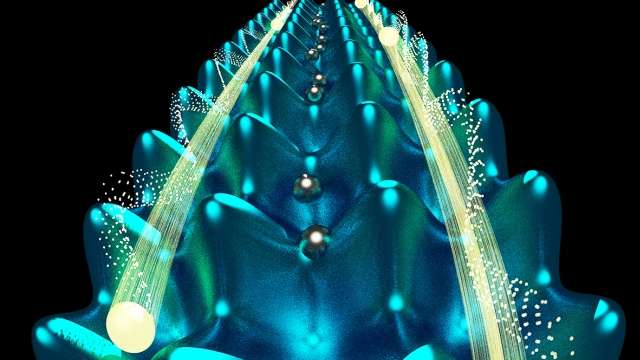At the edge of a quantum gas: Physicists observe skipping orbits in the quantum Hall regime

JQI scientists have achieved a major milestone in simulating the dynamics of condensed-matter systems – such as the behavior of charged particles in semiconductors and other materials – through manipulation of carefully controlled quantum-mechanical models.
Going beyond their pioneering experiments in 2009 (the creation of "artificial magnetism"), the team has created a model system in which electrically neutral atoms are coaxed into performing just as electrons arrayed in a two-dimensional sheet do when they are exposed to a strong magnetic field.
The scientists then showed for the first time that it is possible to tune the model system such that the atoms (acting as electron surrogates) replicate the signature "edge state" behavior of real electrons in the quantum Hall effect (QHE), a phenomenon which forms the basis for the international standard of electrical resistance. The researchers report their work in the 25 September issue of the journal Science.
"This whole line of research enables experiments in which charge-neutral particles behave as if they were charged particles in a magnetic field," said JQI Fellow Ian Spielman, who heads the research team at NIST's Physical Measurement Laboratory.
"To deepen our understanding of many-body physics or condensed-matter-like physics – where the electron has charge and many important phenomena depend on that charge – we explore experimental systems in which the components have no electrical charge, but act in ways that are functionally equivalent and can be described by the same equations," Spielman said.
Such quantum simulators are increasingly important, as electronic components and related devices shrink to the point where their operation grows increasingly dependent on quantum-mechanical effects, and as researchers struggle to understand the fundamental physics of how charges travel through atomic lattices in superconductors or in materials of interest for eventual quantum information processing.
Quantum effects are extremely difficult to investigate at the fundamental level in conventional materials. Not only is it hard to control the numerous variables involved, but there are inevitably defects and irregularities in even carefully prepared experimental samples. Quantum simulators, however, offer precise control of system variables and yield insights into the performance of real materials as well as revealing new kinds of interacting quantum-mechanical systems.
"What we want to do is to realize systems that cannot be realized in a condensed-matter setting," Spielman said. "There are potentially really interesting, many-body physical systems that can't be deployed in other settings."
To do so, the scientists created a Bose-Einstein condensate (BEC, in which ultracold atoms join in a single uniform, low-energy quantum state) of a few hundred thousand rubidium atoms and used two intersecting lasers to arrange the atoms into a lattice pattern.
Then a second pair of lasers, each set to a slightly different wavelength, was trained on the lattice, creating "artificial magnetism"—that is, causing the electrically neutral atoms to mimic negatively charged electrons in a real applied magnetic field.
Depending on the tuning of the laser beams, the atoms were placed in one of three different quantum states representing electrons that were either in the middle of, or at opposite edges of, a two-dimensional lattice.
By adjusting the properties of the laser beams, the team produced dynamics characteristic of real materials exhibiting the QHE. Specifically, as would be expected of electrons, atoms in the bulk interior of the lattice behaved like insulators. But those at the lattice edges exhibited a distinctive "skipping"motion.
In a real QHE system, each individual electron responds to an applied magnetic field by revolving in a circular (cyclotron) orbit. In atoms near the center of the material, electrons complete their orbits uninterrupted. That blocks conduction in the system's interior, making it a "bulk insulator." But at the edges of a QHE system, the electrons can only complete part of an orbit before hitting the edge (which acts like a hard wall) and reflecting off. This causes electrons to skip along the edges, carrying current.
Remarkably, the simulation's electrically neutral rubidium atoms behaved in exactly the same way: localized edge states formed in the atomic lattice and atoms skipped along the edge. Moreover, the researchers showed that by tuning the laser beams – that is, modifying the artificial magnetic field – they could precisely control whether the largest concentration of atoms was on one edge, the opposite edge, or in the center of the lattice.
"Generating these sorts of dynamical effects was beyond our abilities back in 2009, when we published our first paper on artificial magnetism," Spielman said. "The field strength turned out to be too weak. In the new work, we were able to approach the high-field limit, which greatly expands the range of effects that are possible to engineer new kinds of interactions relevant to condensed-matter physics."
The Hall effect occurs when a current traveling in a two-dimensional plane moves through a magnetic field applied perpendicular to the plane. As electrons interact with the field, each begins to revolve in a circular (cyclotron) orbit. That collective motion causes them to migrate and cluster on one edge of the plane, creating a concentration of negative charge. As a result, a voltage forms across the conductor, with an associated resistance from edge to edge.
Much closer, detailed examination reveals the quantum Hall effect (QHE): The resistance is exactly quantized across the plane; that is, it occurs only at specific discrete allowed values which are known to extreme precision. That precision makes QHE the international standard for resistance.
An additional distinctive property of QHE systems is that they are "bulk insulators" that allow current to travel only along their edges.
More information: "Visualizing edge states with an atomic Bose gas in the quantum Hall regime." Science 25 September 2015: Vol. 349 no. 6255 pp. 1514-1518 DOI: 10.1126/science.aaa8515
"Synthetic magnetic fields for ultracold neutral atoms. Nature 462, 628-632 (3 December 2009) | DOI: 10.1038/nature08609
Provided by Joint Quantum Institute



















